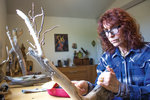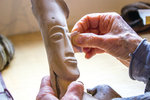Piled up in heaps on local shorelines, what’s food for worms and shelter for shorebirds is the stuff of art for Suzzanne Stangel, and the gnarlier the better.
This item is available in full to subscribers.
We have recently launched a new and improved website. To continue reading, you will need to either log into your subscriber account, or purchase a new subscription.
If you had an active account on our previous website, then you have an account here. Simply reset your password to regain access to your account.
If you did not have an account on our previous website, but are a current print subscriber, click here to set up your website account.
Otherwise, click here to view your options for subscribing.
* Having trouble? Call our circulation department at 360-385-2900, or email our support.
Please log in to continue |
|


Piled up in heaps on local shorelines, what’s food for worms and shelter for shorebirds is the stuff of art for Suzzanne Stangel, and the gnarlier the better.
Once a piece of driftwood catches her eye, Stangel takes it back to her Port Townsend studio where it will become whatever it wants to be, she said, including a Medusa head.
“I have all this wood around and something will catch my attention and I will start and just let it come out.”
The wood knows what it wants to be, she said, echoing the idea attributed to Leonardo DaVinci that every block of stone has a statue in it and the artist’s job is to discover it.
“It keeps changing. It evolves. I really do think it is telling me what is in there and what needs to come out.”
Stangel fled to Port Townsend with her husband, Howard Tucker, about four years ago after tech yuppies crashed their neighborhood, the legendary bohemian enclave of Venice Beach, California.
“The V-13 gangs were better than the Google kids,” Tucker said, referring to a Mexican-American street gang based in the Oakwood neighborhood of Venice. “I won’t even call them gangbangers because we had three generations of Venice 13s on our street - grandma, son and daughter. They would talk to you and engage in conversation.”
It wouldn’t be uncommon for one of them to knock on the front door at 4 a.m. and offer them beers, Tucker said.
Stangel said she felt safe having the gangsters around, saying they were always respectful and would provide a buffer of protection for her when she was coming and going from her home.
The Google crowd was much less sociable, she said.
“People moved in right next door to us and avoided us at all times. It was a total loss of community.”
Before that, Timothy Robert Commerford, bassist for the 90s rock band Rage Against the Machine, lived next door, Stangel said.
There was no need to listen to the radio while chipping away at stone sculptures in her backyard, Stangel said, because Commerford regularly practiced in his garage.
But, being LA, there was crime. One day, Commerford began yelling for help after tackling a man in the alley behind his home, Stangel said.
“He saw a hand come under his garage door and try to open the garage. He ran around to the alley and pinned this guy down. He screamed at me, ‘Suzzanne call the police!.’ We were a community.”
Making TV from everyday life
It wasn’t only at home that Stangel rubbed elbows with rockstars. She worked on several reality TV shows and with several big-name musicians along the way.
“I worked for a producer that did crap reality, but we were always busy. I was in charge of ten shows at a time. It was very stressful.”
Shows Stangel worked on included “Marriage Boot Camp” and “Snoop Dogg’s Fatherhood,” she said.
Turns out that Snoop Doog is as big a pothead as advertised.
Stangel worked in post-production as an editor who ensured the final product made it to the network on time, she said.
Snoop Dogg often would come into the editing rooms to check out the latest cut, she said.
“Smoke would be coming out from under the door. I would open the door and billows of smoke would come out.”
She would protest half-heartedly, she said.
“Snoop, you can’t. This is a non-smoking building.”
He’d say, “That’s OK, babe. I’m OK.”
And that was that. Snoop continued to blaze away.
“He was really cool, really charismatic,” Stangel said.
Before getting into reality TV, Stangel worked with George Schlatter, who was the creator of Rowan & Martin’s Laugh-In and founder of the American Comedy Awards.
“We worked on a big variety of shows with Sammy Davis, Frank Sinatra, Bob Dylan and Bruce Springsteen,” she said.
Frank Sinatra was a smooth operator, Stangel said.
“We actually shot a few things with him over the years.”
After one shoot at Sinatra’s home in Palm Springs, Stangel and her small crew were packing up to go when Ol’ Blue Eyes insisted they hang out for a while.
“No,” he said. “Everybody sit down. We are having drinks.”
Getting out of the fast lane
Nowadays, Stangel has found peace and quiet in Port Townsend, and it was here that she added wood carving to her repertoire.
“When we moved here, it was winter,” she said. “As soon as spring came, and the rain stopped, we were hiking around and went down to the beaches. I could not believe how much driftwood was there.”
There was no driftwood in Southern California, Stangel said, although she did collect shells and beach flotsam on Northern California beaches.
With all that driftwood, Stangel was inspired one day to try and create something. But, she only had stone sculpting tools.
“I started, and then of course I had to get wood carving tools,” she said. “It was totally different.”
Now, carving wood is Stangels passion, or even a compulsion of sorts.
“I can’t stop,” she said. “I keep going.”
A few years on, Stangel has carved about 30 wood pieces, many of which have already been sold.
Stangel is glad to take a break from stone work, she said, although she does still sculpt stone from time to time.
“I sculpted a lot of big pieces. Ninety pounds was the biggest. That was hard on my body, the banging, and on my hands because I would smash my fingers.”
The wood is much easier to work with due to its softer nature and lighter weight, Stangel said.
And, the resulting pieces are extraordinary, Tucker said.
“I think it is otherworldly. It is amazing, I don’t know where the inspiration comes from. I am in awe.”
To view more of Stangel’s work, visit sstangel.com.